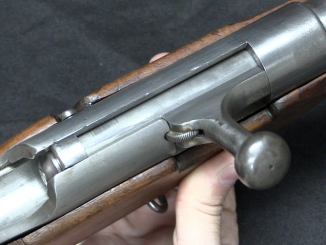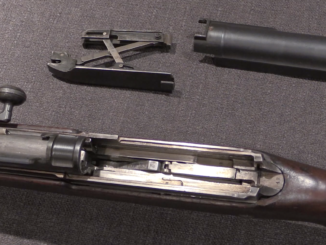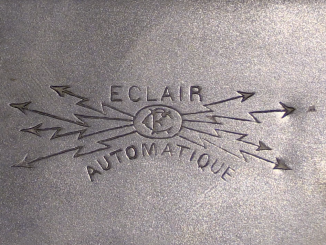Paul Ribeyrolles was the manager of the Gladiator bicycle factory, and by 1918 he had significant experience in small arms design, having been a core member of the team that designed and built the 1915 CSRG Chauchat automatic rifle and the RSC-1917 semiautomatic rifle. These were forward-looking weapons, the first of their types ever to be successfully used in combat. Ribeyrolles continued to pursue the next generation of infantry small arms, and in the summer of 1918 he presented his 1918 automatic rifle for military testing at Versailles.
The model 1918 met most of the requirements to be considered an assault rifle by today’s standards – it used an intermediate cartridge, it could fire in both semiautomatic and fully automatic modes, and it was fed by detachable box magazines (with a capacity of 25 rounds). The cartridge it used was a modification of the .351 Winchester WSL cartridge, modified to be semi-rimmed and to use an 8mm Lebel armor-piercing bullet. Unlike modern weapons of this type, however, Ribeyrolles’ rifle used a simple blowback action and this required a quite heavy bolt to work properly. Unloaded, the weapon weighed 11.25 pounds (5.1kg), and the long receiver necessary for the bolt to effectively decelerate gave it an overall length of 1.09m (43 inches) – this was long and heavy for its capabilities. Still, it was conceptually pretty advanced for 1918.
The biggest problem which prevented the gun from seeing any military interest was reliability. At the 1918 trials, it was very unreliable – the one source I sound said that 53 malfunctions were had in 75 rounds of semiautomatic fire. That is definitely a sign of a design not ready for adoption!
Ribeyrolle brough the gun back for more testing in the summer of 1921 at Camp de Chalons, but it does not appear that he had fully cured the reliability problems. In addition, the gun’s futuristic concept left it out of place in the arms lineup envisioned by the French military. It was too heavy and bulky to fill the role of a personal weapon like a submachine gun (note that the SMG ultimately adopted by the French, the MAS-38, is one of the smallest and lightest such guns ever used by a military power). And because of its intermediate cartridge, with a 400 meter effective range, it was considered too underpowered to fill the role of an infantry rifle. And thus, it was rejected, never to be seen again.
I do not know how many examples of the Ribeyrolles 1918 were actually manufactured, but it was certainly only a few – apparently only 3000 rounds of its ammunition were made for the 1921 testing. To the best of my knowledge, no examples survive today – any that were preserved after the trials were lost or destroyed in the chaos of WWII occupation and liberation.




“RSC-1917 semiautomatic rifle(…)first of their types ever to be successfully used in combat”
Arguable. This self-loading rifle was predated by Meunier rifle and also Winchester Model 1907 (both in French usage).
“SMG ultimately adopted by the French, the MAS-38,”
Yes, but that was 20 years later and earlier French forces used:
https://modernfirearms.net/en/submachine-guns/france-submachine-guns/sta-1922-mas-m1924-eng/
which in terms of dimensions and mass was close to M.P.18,I. This probably made interest in Ribeyrolles design to drop (notice that both design used non-default for French forces cartridge)
“.351 Winchester WSL cartridge, modified to be semi-rimmed and to use an 8mm Lebel armor-piercing bullet”
Then question: why armour-piercing? Also after you look at photos of cartridge:
http://municion.org/8/8x35Ribeyrolle.htm
it look different that intermediate cartridge of today, or of Cold War-era (.280 British to name one). I have many doubts about correctness of that design. Semi-rimmed nature suggest head-space on rim, so there should not be problem, however very short neck spawn doubts about how positively bullet is seated – take in account it was destined to use in full automatic weapon.
One may turn up where it is least expected.
It’s truly a shame that more photos/details on this firearm are mostly unavailable. I’d love to build a reproduction.
We’re getting very close to a gun I really want to see some details on: the “volley fire” (full auto) version of the Winchester 1907. Several thousand actually saw use with the French in the war.
Something tells me that the French wanted a full power battle rifle and not an assault carbine.
Yeah, right. And they wanted it cheap.
They could have used 7.63 Mauser or make a cartridge based on it, just little longer. They could have extracted from defeated Germany what they needed. That kind of concept would be manageable in free recoil/ blowback. It was proven by Russians less than 20 years later.
Simply lengthening and thickening the neck of 7.63 x 25 mm in either it’s Mauser or Tokarev forms would provide much more secure retention of heavier rifle type bullets under recoil.
With suitable chamfering at the front of the chamber, it would also allow the firing of pistol ammunition in guns chambered for the longer thicker necked round, but not the other way around.
Gevarm / Gevlot (from St Etienne) has an interesting patent for its open bolt .22 rf sporters
There’s a weight / guide
That fits into the end of the recoil spring.
You can either have it at the front of the recoil spring, where it contributes extra weight to the bolt for hotter loadings
Or at the back end, where it simply acts as a stationary guide for the recoil spring at the back of the receiver tube, leaving the bolt lighter for reliable operation with lighter loads.
But it’s still there in the gun, so it doesn’t get lost or left at home.
Applied to a 7.63 x 25 mm assault rifle
The weight of the bolt itself and its travel can be copied from any of the good open bolt carbines / smgs
And the spring guide simply maKes up sufficient additional weight to handle the hotter rifle bullet loading.
Strikes me a bit odd that the first “purpose developed” intermediate cartridges were the work of relatively minor powers… Perhaps Fëderov excepted for 6.5mm, although as we all know, he opted for the 6.5x50mmSR Japanese service rifle cartridge for his Avtomat.
Switzerland, Denmark, Italy, eventually Germany during the immediate NSDAP rearmament phase… Perhaps a few others.
As much as I like the 7.5x54mm, it will never cease to puzzle me why when the brüders Mauser offered their rifle in any crazy nationalist cartridge your national military might care for… 6.5x55mm Swedish, 6.5mm Portuguese Vergueiro, etc., or the “bone stock” triad of calibers: “small-bore” 7x57mm (Spain, the Balkans, most of Latin America, etc.), “medium bore” 7.65x53mm (Belgium, Argentina, Bolivia, some other Latin American nations, Ottoman Turkey before they switched, etc.), and “large bore” the 7.92x57mm. Why not “pick” from the available rimless cartridges or one of the odd pre-WWI small-bore experiments like, say, 7mm Meunier or 6.5mm Deaudateau or whatever… Odd, somehow, particularly insofar as if war with Germany resumed, likely as not Belgium would at least be a co-belligerent if not exactly an ally… Ah well. One can’t “Monday morning quarterback” such historical decisions. And lest anyone think I’m being unduly harsh on the French arms industry, the UK stuck with the rimmed .303″ without ever opting for a rimless cartridges due to budgetary constraints, emphasis on the Royal Navy and RAF postwar, etc.
“Fëderov(…)opted”
No, he has not choice here, his 6,5 mm cartridge was in full-power category:
8,5 g bullet at ~850 m/s for around 3100 J
it was tested, but with outbreak of war starting production of entirely new cartridge was considered bad idea.
“I like the 7.5x54mm”
Initially it case was somewhat longer and it was close to 7,9 x 57, first iteration of this weapon: https://en.wikipedia.org/wiki/FM_24/29_light_machine_gun
would chamber German round, but if it would be fired it would have disastrous effects, so French decided to shorten it to prevent such possibility.
“odd pre-WWI small-bore experiments like, say, 7mm Meunier or 6.5mm Deaudateau or whatever… ”
Cartridges around 6,5 mm were generally adopted into service in 1890s-1900s, but fell out of favor after Great War, I would says reasons were as follow:
– military usage of flying devices, which caused creation of AA weapons (including rifle-caliber MG) and air-to-air weapons, mainly rifle-caliber MG – in that application bigger bullet was better, as allowed more HE or incendiary filler
– appearance of tanks, popularization of armoured vehicles in general – here more energy at impact was desirable, rifle caliber AP bullets were popular (and viable taking in account armour of then used vehicles) solution in interbellum.
– bigger usage of rifle-caliber machine gun including indirect fire – here bigger reach is desirable
so after 1918, so far I know, there was not nation to adopt 6,5 mm cartridge as their default rifle cartridge. Where 6,5 mm was already in inventory there was often search for new “machine gun only” cartridge, but which will fit into “standard” size weapon, for example Sweden adopted patron m/32 which was 8x63mm for that purpose.
“eventually Germany during the immediate NSDAP rearmament phase”
rearmament is key word here, as Germans lost almost all heavier weapons in effect of Versailles Treaty, thus they have not “burden” of “older pattern” weapons, thus they must produce new weapons, when for example British could say: that 2-in-1 machine gun is interesting idea, but we are content with Lewis and Vickers machine gun already present in our inventory.